英语阅读思维导图
- 格式:docx
- 大小:13.98 KB
- 文档页数:3
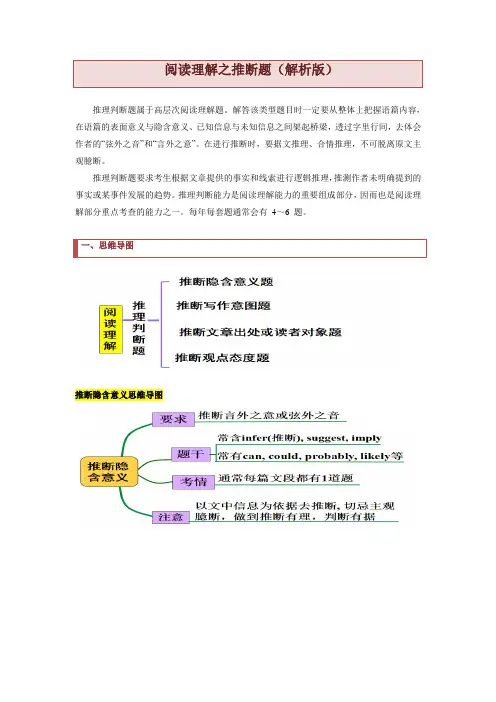
阅读理解之推断题(解析版)推理判断题属于高层次阅读理解题。
解答该类型题目时一定要从整体上把握语篇内容,在语篇的表面意义与隐含意义、已知信息与未知信息之间架起桥梁,透过字里行间,去体会作者的“弦外之音”和“言外之意”。
在进行推断时,要据文推理、合情推理,不可脱离原文主观臆断。
推理判断题要求考生根据文章提供的事实和线索进行逻辑推理,推测作者未明确提到的事实或某事件发展的趋势。
推理判断能力是阅读理解能力的重要组成部分,因而也是阅读理解部分重点考查的能力之一。
每年每套题通常会有4~6 题。
一、思维导图推断隐含意义思维导图二、方法点拨(一)推理判断题题干常用词一般来说,推理判断题题干中主要包括下面的词语:know about, learn from, infer, imply, suggest, conclude, purpose, attitude, probably, most likely等。
(二)推理判断题正确选项特征推理判断题中的正确选项是依据文章的事实或证据推断出的符合逻辑的结论或观点,正确选项一般具有以下特征:1.“立足原文,只推一步”,即根据原文内容,一步即可推得。
2.选项中一般不可以出现绝对概念。
如only, never, all, absolutely等,正确答案的表述一般有一点模糊,会用一些相对能够留有一些余地的词汇,如often, usually, sometimes, some, may, might, can, could, possibly, probably等。
(三)推理判断题干扰选项特征1.曲解文意:即推测意义与文章表层意义有区别。
推理判断题中有些选项来自文章中的某一句或某几句话,命题者可能会利用里面的词设计出干扰项,看似表达文章的意思,其实是借题发挥,是对原文意思的曲解。
2.张冠李戴:即把文章中作者的观点与其他人的观点混淆在一起。
题干问的是作者的观点,选项中出现的却是其他人的观点;题干问的是其他人的观点,选项中却出现了作者的观点。
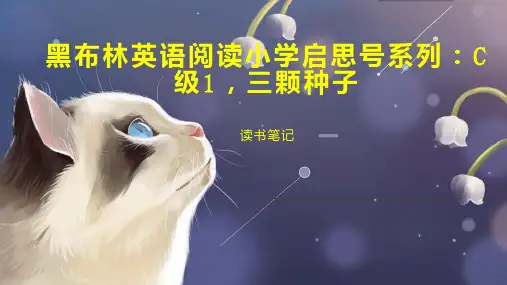

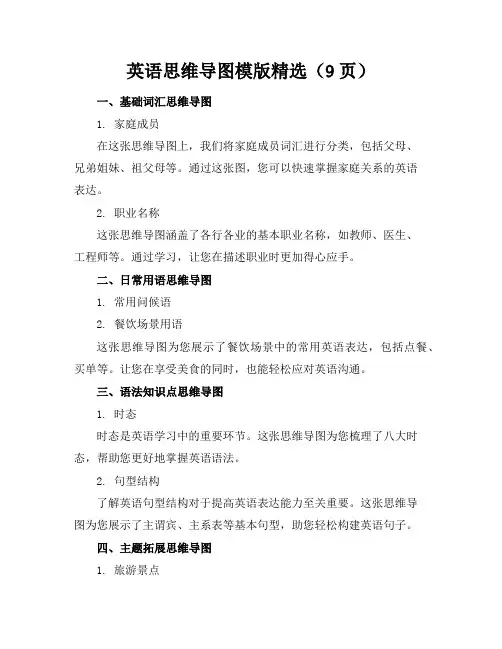
英语思维导图模版精选(9页)一、基础词汇思维导图1. 家庭成员在这张思维导图上,我们将家庭成员词汇进行分类,包括父母、兄弟姐妹、祖父母等。
通过这张图,您可以快速掌握家庭关系的英语表达。
2. 职业名称这张思维导图涵盖了各行各业的基本职业名称,如教师、医生、工程师等。
通过学习,让您在描述职业时更加得心应手。
二、日常用语思维导图1. 常用问候语2. 餐饮场景用语这张思维导图为您展示了餐饮场景中的常用英语表达,包括点餐、买单等。
让您在享受美食的同时,也能轻松应对英语沟通。
三、语法知识点思维导图1. 时态时态是英语学习中的重要环节。
这张思维导图为您梳理了八大时态,帮助您更好地掌握英语语法。
2. 句型结构了解英语句型结构对于提高英语表达能力至关重要。
这张思维导图为您展示了主谓宾、主系表等基本句型,助您轻松构建英语句子。
四、主题拓展思维导图1. 旅游景点这张思维导图为您介绍了世界各地的旅游景点,包括自然风光、人文景观等。
让您在规划旅行时,也能学到实用的英语表达。
2. 节日习俗了解各国节日习俗,有助于拓宽国际视野。
这张思维导图为您展示了中西节日的庆祝方式,让您在跨文化交流中更加得体。
五、提升听说能力思维导图1. 英语听力场景为了帮助您提高英语听力,这张思维导图精选了多种听力场景,如机场、电影院、超市等。
通过针对性的场景练习,让您在实际交流中更加游刃有余。
2. 口语表达技巧提升口语能力,不仅需要积累词汇,还要掌握表达技巧。
这张思维导图为您提供了各种口语表达技巧,如连读、弱读、语调等,让您的英语口语更加地道。
六、阅读理解思维导图1. 阅读策略提高阅读理解能力,策略至关重要。
这张思维导图为您介绍了略读、寻读、精读等阅读策略,帮助您更高效地阅读英语文章。
2. 文章结构解析了解文章结构对于把握文章大意至关重要。
这张思维导图为您分析了英语文章的常见结构,如引言、、结论等,让您在阅读时能更快地捕捉关键信息。
七、写作技巧思维导图1. 写作框架搭建写作时,一个清晰的框架能让您的文章更有条理。
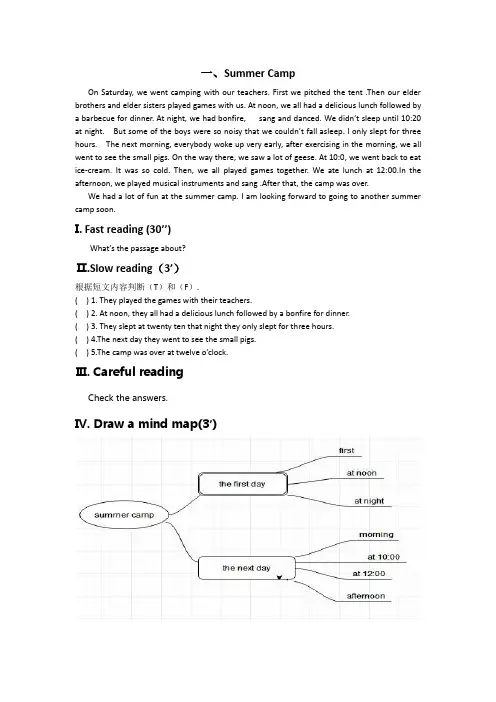
一、Summer CampOn Saturday, we went camping with our teachers. First we pitched the tent .Then our elder brothers and elder sisters played games with us. At noon, we all had a delicious lunch followed by a barbecue for dinner. At night, we had bonfire, sang and danced. We didn’t sleep until 10:20 at night. But some of the boys were so noisy that we couldn’t fall asleep. I only slept for three hours. The next morning, everybody woke up very early, after exercising in the morning, we all went to see the small pigs. On the way there, we saw a lot of geese. At 10:0, we went back to eat ice-cream. It was so cold. Then, we all played games together. We ate lunch at 12:00.In the afternoon, we played musical instruments and sang .After that, the camp was over.We had a lot of fun at the summer camp. I am looking forward to going to another summer camp soon.I. Fast reading (30’’)What’s the passage about?Ⅱ.Slow reading(3’)根据短文内容判断(T)和(F).( ) 1. They played the games with their teachers.( ) 2. At noon, they all had a delicious lunch followed by a bonfire for dinner.( ) 3. They slept at twenty ten that night they only slept for three hours.( ) 4.The next day they went to see the small pigs.( ) 5.The camp was over at twelve o’clock.Ⅲ. Careful readingCheck the answers.Ⅳ. Draw a mind map(3’)Ⅴ. Summary(2’)二、Robert went to visit his friends in Paris last weekend. His friends, met him at the airport on Friday afternoon and drove him to hotel. They are dinner at a Chinese restaurant and went to see a film after that.Robert and his friends set our early on Saturday morning for a farm and stayed there until Sunday morning. During their stay there, they played football in the field and enjoyed a big meal around a camp fire singing and dancing till late into the night.Nobody could get up early on Sunday morning, so when they got back to Paris, it was about three o’clock in the afternoon. They drove right to the airport because Robert didn’t want to miss his plane back home. Robert only stayed in Paris for two nights, but he had a great time with his friends.I. Fast reading (30’’)What’s the passage about?Ⅱ.Slow reading(3’)选择正确答案:()1.Where did Robert go last weekend?A .To New YorkB .To London C. To Paris D. To Beijing( ) 2.What did Robert and his friends do after dinner Friday?A. They went for a driverB. They played footballC. They went back to the hotelD. They saw a film( )3. What didn’t they do on the farm?A.They sang and dancedB. They played footballB.They rode bikes D. They enjoyed a big meal around a camp fire.( ) 4.What time did they get back to Paris?A about 5:00 a.m C. about 3:00 a.mB about 5:00 p.m D. about 3:00 p.m( ) 5.How long did Robert stay in Paris?A. about three yearsB. four daysC. one dayD. two daysⅢ. Careful readingCheck the answers.Ⅳ. Draw a mind map(3’)Ⅴ. Summary(2’)三、Dear DonaldLast summer I had a chance to visit the other side of the world. I went to Beijing with my friends. I visited the Great Wall and was deeply impressed by its length. I had never seen such a great wall before! Walking less than a mile on the wall made me very tired, but I was very excited.I used up three camera films in four hours.Shopping was another interesting part of the trip, in the Silk Market, I bought a silk shirt for just a quarter for the price the trader asked for.I have many memories and experiences to share .I am so lucky because I saw a culture so different form my own. I will remember my trip to China forever!Yours,Jane.I. Fast reading (30’’)What’s the passage about?Ⅱ.Slow reading(3’)根据短文回答问题:1.Who visited Beijing last summer?2.How many camera films did Jane use up in four hours on the Great Wall?3.Which was another interesting part of the trip?4.Did Jane buy a silk shirt?5.Why is Jane so lucky?Ⅲ. Careful readingCheck the answers.Ⅳ. Draw a mind map(3’)Ⅴ. Summary(2’)一、I am Lucy, I had a summer camp with my classmates last year.Early in the morning, we gathered at the bus station. After saying goodbye to our parents, we got on the buses. It took us more than two hours to arrive at the camp ground. We got off the buses cheerfully. Laughing and shouting, we jumped and ran all over the place. It was the first time for us to be away from the parents .Some of us started to feel homesick. However, when the night party and dances began, the homesickness was gone.The next day, everybody rushed to the boating class, hopping to beat the head of the others. At first, my friends and I worked hard,but the boat wouldn’t listen to us and kept going round and round . Then the teacher taught us how to work together. After many tries, we did much better. Swimming class was my favorite. It was about the hottest time of a day and the best time to stay in the cool water. The swimming teacher was a funny man and during the class he often made us laugh happily.We had a lot of fun during the camp. I want to join it again as I learned a lot of new things and made many new friends.I .Fast reading (30’’)What’s the passage about?Ⅱ.Slow reading(3’)根据短文回答问题:1.What did Lucy do last year?2.How did they go there?3.Did they have a great time during the camp?4.How many classes did they have the next day?5.Why does Lucy want to join it again?Ⅲ. Careful readingCheck the answers.Ⅳ. Draw a mind map(3’)Ⅴ. Summary(2’)二、Most American families like to have vacation in summer. Summer is a good time for vacation. It is often hot in July and August.Children do not go to school in those two months. Some like to stay at home, read books, stay with their families or watch TV. Many families take their lunch to eat at a place with many trees or near a nice lake. Some people have enough time and money to travel to other countries like France, Japan and Australia. They usually fly to these countries. Many families travel by car or train to see interesting places in their own countries. Their favorite cities are New York, Chicago, Miami, San Francisco and Los Angeles.Not everyone likes to go to busy cities, some families travels to mountains or beautiful valleys.I. Fast reading (30’’)What’s the passage about?Ⅱ.Slow reading(3’)选择正确答案:()1.From the passage we know is a good time for vacation.A.SpringB. summerC. autumnD. winter( )2. Some children like to stay at home during their vacation, they don’tA.Read booksB. stay with their familiesC. watch TVD. go to school( ) 3. Many families like to have their lunch during their vacation.A in the officeB near a cinemaC near a big factoryD near a nice lake( ) 4. If you have you can travel to other countries.A money and friendsB friends and timeC money and timeD food( ) 5.Chicago isA.芝加哥B. 纽约C. 荷兰D. 洛杉矶Ⅲ. Careful readingCheck the answers.Ⅳ. Draw a mind map(3’)Ⅴ. Summary(2’)三、Mr. and Mrs .Green lived in a big city, and one summer they went to the country for their holiday. They enjoyed it very much, because it was a quiet and clean place.One day they went for a walk early in the morning and met an old man. He lived on a farm, and he was sitting in the warm sun in front of his house. Mr. Green asked him “Do you like to live in this quiet place?” The old man said “Yes, I do.” Mr. Green said “What are the good things about it ?” The old man answered “Well, the people here know each other, they often come and see me, and I often go and visit them, and there are also lots of children here.” Mr. Green said “That’s interesting. And what are the bad things?”The old man thought and thought, and then said “Well, the same things really!”I. Fast reading (30’’)What’s the passage about?Ⅱ.Slow reading(3’)选择填空:()1.Mr. and Mrs. Green the country very much, because it was a quiet and clean place.A likedB likeC livedD live( )2.One day they for a walk early in the morning.A went toB went outC went upD went down( )3.The old man enjoyed the country.A veryB toC alsoD much( )4.The people in the country are very .A friendB friendlyC cleverD carefulⅢ. Careful reading Check the answers.Ⅳ. Draw a mind map(3’)Ⅴ. Summary(2’)。
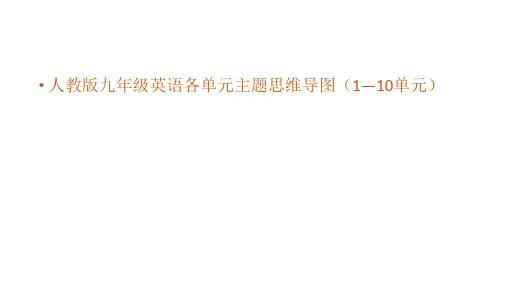
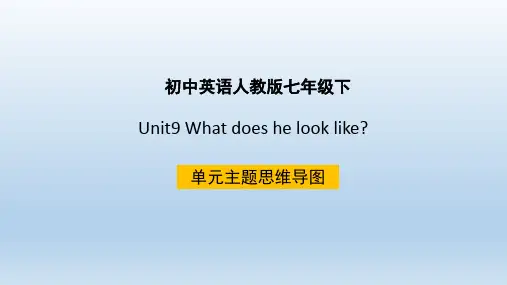
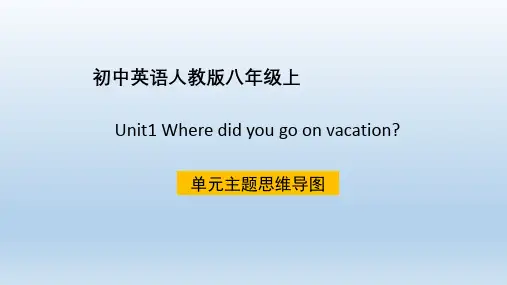
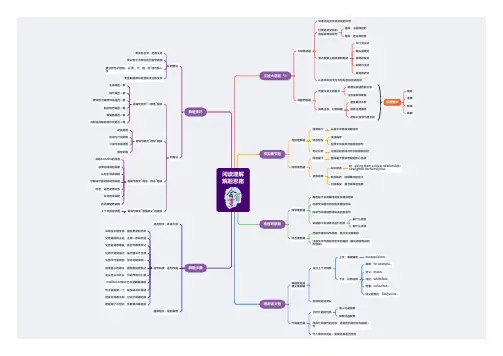

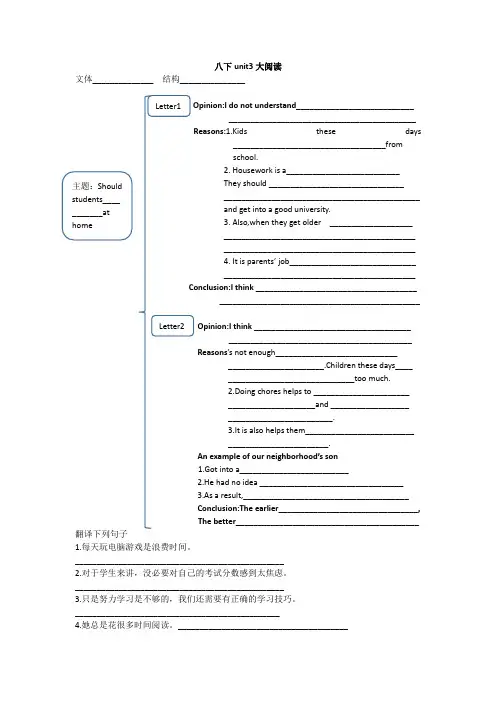
八下unit3大阅读文体______________ 结构_______________Opinion:I do not understand___________________________ ___________________________________________ Reasons:1.Kids these days___________________________________fromschool.2. Housework is a__________________________They should _______________________________ _____________________________________________and get into a good university. 3. Also,when they get older ___________________ ________________________________________________________________________________________4. It is parents’ job_________________________________________________________________________Conclusion:I think ___________________________________________________________________________________Opinion:I think ______________________________________________________________________________Reasons ’s not enough____________________________ ______________________.Children these days____ _____________________________too much.2.Doing chores helps to ______________________ ____________________and __________________ ________________________.3.It is also helps them_________________________ _______________________.An example of our neighborhood’s son1.Got into a_________________________2.He had no idea _________________________________3.As a result,______________________________________ Conclusion:The earlier________________________________, The better__________________________________________ 翻译下列句子1.每天玩电脑游戏是浪费时间。
思维导图指导英语名著《威尼斯商人》的阅读案例通过学习发散性思维指导阅读教学,我有了很多感悟,于是拿了一篇名著,The Merchant of Venice,画了思维导图,通过分析人物特点,帮助学生理解并记住文章的主要内容,而且,通过两个问题,帮助学生拓展思路,包括:What do you think of Antonio / Bassonio / Partia / Shy lock?Can you give them any suggestions?以下是思维导图:这些思维导图,可以拓展学生思路,帮助他们跳出故事原来的条框去思考问题。
例如:Antonio 虽然是个大好人,对于朋友两胁插刀、鼎力相助,毫不计较个人利益,但在危险面前,过度大意,导致让Shylock 有机可乘,差点要了Antonio的性命。
所以,在导图的最后,我建议学生在帮助别人的时候,如果有潜在的危险,应该三思而后行,避免人身安全受到威胁。
(Think twice before doing sth. dangerous.)还有Bassoino这个人物,虽然表面看上去是个好人,但他也有过于依赖朋友、不够真诚的一面。
为了接近Partia,他向Antonio借钱,而且知道Antonio 暂时也很困难的时候,没有自己承担起责任,想别的办法,而是在Antonio陪同下,去找Shylock,导致悲剧的差点发生。
所以从这个方面来看,Bassoion有软弱无能、不够承担的特点,如果要给他建议,我想应该是“Do what you can do.”"Be independent./Don't rely on others.)至于Partia,她很聪明、而且勇敢,在Bassoino也束手无策的时候,她写信给当律师的表兄请教救人方法,之后女扮男装,在法庭上勇斗Shylock,设下圈套等他一步步走进去,并及时收网,让他进退两难,最终选择放弃杀害Antonio。
高中英语阅读理解,思维导图解析法
阅读理解分为细节理解题,推理判断题,词义猜测题和主旨大意题四种
细节理解题:主要是要求学生对文中某一细节、或重要事件的辨认和理解。
推理判断:根据文中作者所描述的细节,事实以及作者的语言找出能够,表达作者思想倾向和感情
色彩的词,进而进行推理和判断,找出符合逻辑的结论。
推理判断题,题干中会隐含一定的条件,用标志性的词语来判断作者的观点和态度,以及写作目的和文章的出处
词义猜测题:主要是找准关键词。
判断词义猜测题时,可以通过,1、定义或解释说明2、对比关系3、因果关系
4、同义词近义词区分
5、举例法
6、并通过生活经验,生活常识进行逻辑推理,还可
5、根据生词所在的上下文,猜测词义,常见的前缀,词根和后缀,都可以成为猜测词义的条件。
主旨判断题:一般是判断短文的标题,主题大意或者段落大意,先找出各段的主题句,寻找作者所使用的论据,进行归纳总结和概括。
小王子英语思维导图完整版
作业总结:图画好了好几天,一直没有抽出时间来整理。
这节课是思维导图阅读法,并以《小王子》为例进行解析。
思维导图最主要应用应该就是在阅读上了,要用思维导图的方法进行阅读,找对方法多练习是最重要的,练习时从简单到复杂,从诗词到文章再到书,从简单易懂的书到专业困难的书,循序渐进的学习和练习。
我们要深度阅读一本书,需要速读、细读再精读,需要有计划有步骤的读,需要边读边做笔记,读过之后还要进行总结和回顾,提升记忆力。
作业难点:
1、还是没有办法听一遍就梳理出关键词,有些比较难的句子需要重复回听。
2、分支线条粗细还需要练习,小图标也画得不够好。
英语阅读思维导图
英语阅读思维导图
英语阅读思维导图
一、思维导图
1.关于思维导图的认识
脑科学研究表明,大脑神经是由中心向外发散的神经元。
运用思
维导图,使人的思维方式更贴近大脑自身的思维方式,这样与大脑进
行对话、交流就会变得直接、自然和简单。
通俗地说,思维导图是一
个简单、有效、美丽的思维工具,它依据全脑的概念,按照大脑自身
的规律指导思考,全面调动左脑的逻辑、顺序、条例、文字、数字思
维以及右脑的图像、想象、颜色、空间、整体思维,使大脑潜能得到
最充分的开发,从而极大地发掘人的记忆、创造、身体、语言、精神、社交等各方面的潜能。
也就是说,它采用从中心向四周发散的结构,
即它的中心是中心主题,然后从中心主题引出一系列与中心主题相关
的各个子主题,再从子主题引出次主题,依此类推。
而整个思维导图
都由线条、图形、颜色、词汇、符号等元素构成。
2.思维导图的特点
(1)重点突出,结构清晰。
(2)模拟人脑神经元分布的结构,易于促使人们产生新的想法。
(3)把主要起处理语言、逻辑、数学和次序的
作用,即所谓的学术学习作用的大脑左半部分以及处理节奏、旋律、
音乐、图像和幻想,即所谓的创造性活动的大脑右半部分一起调动起来。
(4)把人们/看不见、摸不着0的想法外显出来,从而促进人们之
间的交流。
二、英语任务型阅读
从一定程度上来说,该题型能考查考生语感的流利程度、思维的灵活性、词汇辨析能力和语篇概括能力。
该题型要求考生在阅读所
给语言材料的基础上对相关信息进行加工,在读懂文章、把握主题、理清脉络和审清题意的基础上完成相关文字表达的任务。
三、思维导图在英语任务型阅读教学中的应用
1.思维导图对英语任务型阅读的作用
(1)有助于学生从整体上认识和把握整篇阅读文章。
思维导图以放射性思考为基础的收放自如方式,是一种展现个人智力潜能的方法,可提升思考技巧,增强记忆力、组织力与创造力。
思维导图可以让复杂的问题变得非常简单,简单到可以在一张纸上画出来,让人一下看
到问题的全部并对问题加以延伸。
因为思维导图能把人们看不见、
摸不着的想法外显出来,所以学习者可以无限次地使自己原来的思维过程和知识结构得以重现,并且可以把自己的思维过程和知识结构拿出来与别人进行共享、交流,进而进行反思、总结,从而使学习者对
于自己的认知能力和认知活动能够有更深刻的了解,使其综合思维能力和元认知能力得到提高,并逐渐成为能够进行自我指导和自主学习的'学习者。
(2)有助于学生对知识注入更多的自我思考。
(3)有助于调动存储在学生大脑中的英语知识,激活学生的思维。
(4)有助于学生发散性思维和创造性思维的形成,提高分析问题、解决问题的能力。
2.具体实施策略
首先,从挖掘教材内涵入手,每位学生对将要设计的主题,绘制一幅思维导图;其次,各讨论小组内交流自己制作的思维导图,同时约定在交流过程中,不允许批评别人的想法,所有的意见记录下来,任何人不下判断性的结论,集中注意力,不允许私下交流,尽可能地发散、联想;再次,英语教师对交流的相关信息,进行整理和归纳,并要求学生
完成根据思维导图设计而成的任务型阅读。
在设计过程中,主要围绕如下内容:(1)关键词。
思考:文章的中心是什么?句子的要点到底是
什么?(2)关键知识点。
把主要精力集中在关键的知识点上。
(3)关键知识点之间的连接线。
它会引导你思考:关键词之间有怎样的联系?(4)完整的关键词结构图。
它可以为知识的融会贯通创造极其有利的条件。
利用思维导图,学生可以更好地围绕主题,进行充分联想、发散性思考,将与主题相关联的知识分层分类进行管理,使思维导图真正成为其学习地图。
虽然思维导图在我国教育领域中已经不是一个新事物,但是,我们怎样有效运用思维导图提高学生英语任务型阅读能力却是个值得探索的话题。
只要我们锐意改革、用心探索,一定能够发现更多有益于英语教学的切入点,使我国的中学英语教学走入一个新的层面!。